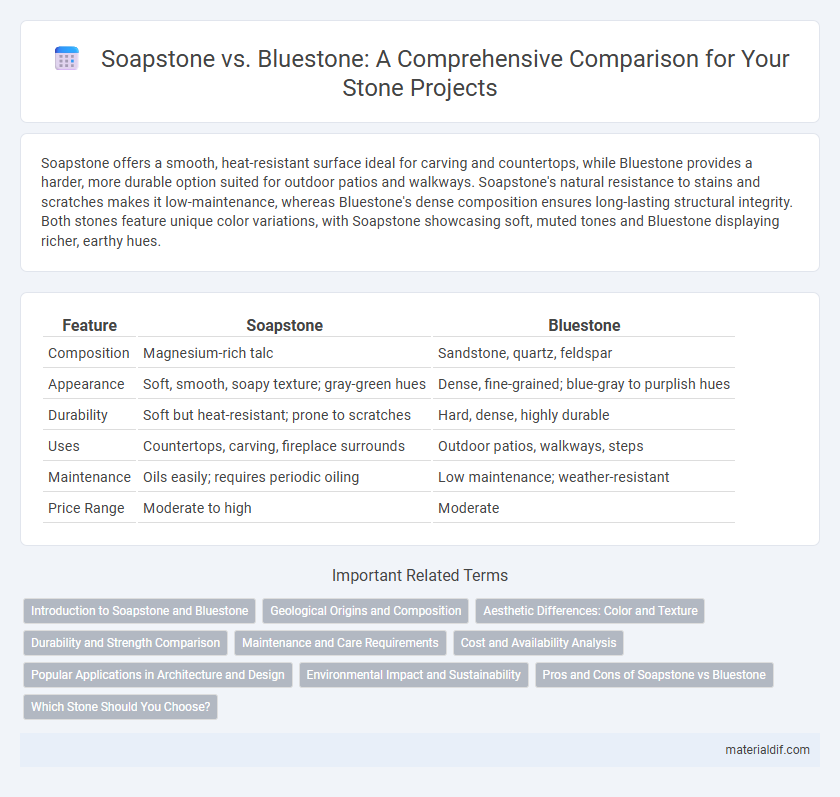Soapstone offers a smooth, heat-resistant surface ideal for carving and countertops, while Bluestone provides a harder, more durable option suited for outdoor patios and walkways. Soapstone's natural resistance to stains and scratches makes it low-maintenance, whereas Bluestone's dense composition ensures long-lasting structural integrity. Both stones feature unique color variations, with Soapstone showcasing soft, muted tones and Bluestone displaying richer, earthy hues.
Table of Comparison
| Feature | Soapstone | Bluestone |
|---|---|---|
| Composition | Magnesium-rich talc | Sandstone, quartz, feldspar |
| Appearance | Soft, smooth, soapy texture; gray-green hues | Dense, fine-grained; blue-gray to purplish hues |
| Durability | Soft but heat-resistant; prone to scratches | Hard, dense, highly durable |
| Uses | Countertops, carving, fireplace surrounds | Outdoor patios, walkways, steps |
| Maintenance | Oils easily; requires periodic oiling | Low maintenance; weather-resistant |
| Price Range | Moderate to high | Moderate |
Introduction to Soapstone and Bluestone
Soapstone, a metamorphic rock primarily composed of talc, is renowned for its heat resistance, softness, and ease of carving, making it ideal for countertops and sculptures. Bluestone, a dense, fine-grained sandstone typically found in the Northeastern United States, offers exceptional durability and a distinctive blue-gray color perfect for outdoor paving and architectural elements. Both stones serve unique functional and aesthetic purposes, with soapstone prized for thermal properties and bluestone valued for its strength and weather resistance.
Geological Origins and Composition
Soapstone, primarily composed of talc, originates from metamorphic processes involving the alteration of ultramafic rocks, resulting in its characteristic softness and heat resistance. Bluestone, a dense sandstone formed through sedimentary processes, consists mainly of quartz and feldspar, lending it significant durability and a blue-gray hue. The distinct geological origins and mineral compositions of soapstone and bluestone influence their respective textures, hardness, and suitability for various architectural and sculptural applications.
Aesthetic Differences: Color and Texture
Soapstone features a smooth, matte surface with a warm, earthy palette ranging from gray-green to deep charcoal, offering a soft and organic aesthetic ideal for countertops and sculptures. Bluestone, in contrast, presents a more rugged texture with a predominantly blue-gray to steel-blue color spectrum, often displaying subtle veining and speckling that enhance its natural, rustic appeal in paving and architectural applications. The distinct color vibrancy and textural variations between soapstone and bluestone cater to different design preferences, where soapstone's uniformity contrasts with bluestone's dynamic, natural character.
Durability and Strength Comparison
Soapstone exhibits moderate durability with a density around 2.5 g/cm3 and is known for its softness, rating 1-2 on the Mohs hardness scale, making it easier to shape but less resistant to scratches and impact. Bluestone, a dense sandstone averaging 2.7 g/cm3, scores higher in strength with a Mohs hardness of 6-7, providing superior resistance to abrasion and weathering. For applications requiring robust structural integrity and long-term durability, bluestone outperforms soapstone due to its greater hardness and compressive strength.
Maintenance and Care Requirements
Soapstone requires minimal maintenance due to its non-porous nature, making it resistant to stains and bacteria, while occasional application of mineral oil enhances its natural patina. Bluestone, being more porous, demands regular sealing to prevent water absorption and staining, especially in outdoor settings. Both stones benefit from gentle cleaning with pH-neutral cleaners to preserve their surface integrity and appearance.
Cost and Availability Analysis
Soapstone generally commands a higher price due to its durability and resistance to heat, making it a premium choice for countertops and sinks. Bluestone tends to be more affordable and widely available, especially in regions like the northeastern United States, where it is commonly quarried. Availability of soapstone can be limited depending on geographic location, whereas bluestone benefits from more consistent supply chains and lower transportation costs.
Popular Applications in Architecture and Design
Soapstone is widely used for kitchen countertops and bathroom sinks due to its heat resistance and smooth texture, making it ideal for functional surfaces in residential design. Bluestone is popular in outdoor applications such as patios, walkways, and pool surrounds because of its durability and natural slip resistance in wet conditions. Both stones offer unique aesthetic qualities, with soapstone providing a soft, matte finish and bluestone delivering a rugged, textured appearance favored in landscape architecture.
Environmental Impact and Sustainability
Soapstone, composed primarily of talc, is an eco-friendly material due to its low-energy extraction and minimal chemical processing, making it sustainable for long-term use. Bluestone, a dense sandstone, requires more intensive quarrying and processing, which increases its carbon footprint but remains durable and recyclable. Both stones offer sustainable options, with soapstone favored for low-impact production and bluestone valued for its longevity and recyclability in construction.
Pros and Cons of Soapstone vs Bluestone
Soapstone offers exceptional heat resistance and a smooth, non-porous surface that resists stains and bacteria, making it ideal for kitchen countertops and fireplaces. Bluestone, a dense, durable sandstone, excels in outdoor applications like patios and walkways due to its slip resistance and ability to withstand harsh weather conditions. However, soapstone is softer and prone to scratches and dents, while bluestone can be more expensive and requires sealing to prevent water absorption and potential damage.
Which Stone Should You Choose?
Soapstone offers superior heat resistance and a smooth, non-porous surface ideal for countertops and fireplaces, while Bluestone provides exceptional durability and rich blue-gray tones perfect for outdoor patios and walkways. Choosing between Soapstone and Bluestone depends on specific needs: opt for Soapstone for indoor applications requiring stain resistance and a warm feel, and select Bluestone for high-traffic outdoor areas demanding strength and weather resistance. Both stones are natural and sustainable options, but their distinct properties make them suitable for different design and functional purposes.
Soapstone vs Bluestone Infographic

 materialdif.com
materialdif.com